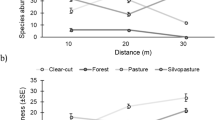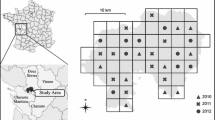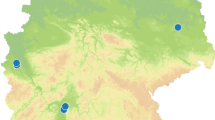Abstract
Context
The response of rare species to human land use is poorly known because rarity is difficult to study; however, it is also important because rare species compose most of biodiversity, and are disproportionately vulnerable. Regional bee pollinator faunas have not been assessed for rarity outside of Europe. Therefore, we do not know to what extent anthropogenic landscapes support rare North American bee biodiversity.
Objectives
We ask how richness and abundance of bee species respond to land use, within quartiles of species defined by their numerical, phenological, and geographical rarity.
Methods
We conducted a field study to sample bee communities in forested, agricultural, and urban landscapes replicated across a large spatial extent of the northeastern United States. We used large independent data sets to classify observed bee species according to three forms of rarity: their numerical rarity (low regional frequency in a museum-based data set), phenological rarity (short flight season length) and geographical rarity (small range size).
Results
For all three forms of rarity, we found half as many rare bee species in agricultural landscapes compared to forest. We found half as many phenologically rare species in urban landscapes. Bees that had both shorter flight seasons and smaller range sizes were between one-third and one-half as rich in both types of anthropogenic landscapes, regardless of regional frequency.
Conclusions
Although a minority of rare bee species were found in anthropogenic landscapes, our overall conclusion is that the native vegetation of our region, forest, is critical for supporting rare bee biodiversity.



Similar content being viewed by others
References
Arduser M (2016) Key to Osmia females known from eastern North America (east of the Great Plains). https://www.pwrc.usgs.gov/nativebees/Keys.html Accessed 1 Oct 2016
Ascher JS (2006–2017) AMNH BEES species occurrence database. http://www.discoverlife.org/mp/20m?kind=AMNH_BEES. Accessed 1 Nov 2017
Baldock KCR, Goddard MA, Hicks DM, Kunin WE, Mitschunas N, Osgathorpe LM, Pott SG, Robertson KM, Scott AV, Stone GN, Vaughan IP, Memmott J (2015) Where is the UK’s pollinator biodiversity? The importance of urban areas for flower-visiting insects. Proc R Soc B 282:20142849
Bartomeus I, Ascher JS, Gibbs J, Danforth BN, Wagner DL, Hedtke SM, Winfree R (2013) Historical changes in northeastern US bee pollinators related to shared ecological traits. Proc Natl Acad Sci 110:4656–4660
Bates D, Maechler M, Bolker BM, Walker S (2015) lme4: linear mixed-effects models using Eigen and S4. R Packag. version 1.7
Blair RB (2001) Birds and butterflies along urban gradients in two ecoregions of the United States: is urbanization creating a homogeneous fauna? In: Lockwood JL, Mckinney ML (eds) Biotic homogenization. Springer, New York, pp 33–56
Bouseman JK, LaBerge WE (1979) A revision of the bees of the genus Andrena of the Western Hemisphere. Part IX. Subgenus Melandrena. Trans Am Entomol Soc 104:275–389
Cardillo M, Mace GM, Gittleman JL, Mace GM, Purvis A (2008) The predictability of extinction: biological and external correlates of decline in mammals. Proc R Soc B 275:1441–1448
Cardoso P, Erwin TL, Borges PAV, New TR (2011) The seven impediments in invertebrate conservation and how to overcome them. Biol Conserv 144:2647–2655
Cariveau DP, Winfree R (2015) Causes of variation in wild bee responses to anthropogenic drivers. Curr Opin Insect Sci 10:1–6
Coddington JA, Agnarsson I, Miller JA, Kuntner M, Hormiga G (2009) Undersampling bias: the null hypothesis for singleton species in tropical arthropod surveys. J Anim Ecol 78:573–584
Coelho BWT (2004) A review of the bee genus Augochlorella (Hymenoptera: Halictidae: Augochlorini). Syst Entomol 29:282–323
Collen B, Dulvy NK, Gaston KJ, Gärdenfors U, Keith DA, Punt AE, Regan HM, Böhm M, Hedges S, Seddon M, Butchart SHM, Hilton-Taylor C, Hoffmann M, Bachman SP, Akçakaya HR (2016) Clarifying misconceptions of extinction risk assessment with the IUCN Red List. Biol Lett 12:1424–1442
Davies KF, Margules CR, Lawrence JF (2004) A synergistic effect puts rare, specialized species at greater risk of extinction. Ecology 85:265–271
Dray S, Legendre P (2008) Testing the species traits-environment relationships: the fourth-corner problem revisited. Ecology 89:3400–3412
Fowler J (2016) Specialist bees of the northeast: host plants and habitat conservation. Northeast Nat 23:305–320
Gaston KJ (1996) Species-range-size distributions: patterns, mechanisms and implications. Trends Ecol Evol 11:197–201
Gibbs J (2011) Revision of the metallic Lasioglossum (Dialictus) of eastern North America (Hymenoptera: Halictidae: Halictini). Zootaxa 1–216
Gibbs J, Packer L, Dumesh S, Danforth BN (2013) Revision and reclassification of Lasioglossum (Evylaeus), L. (Hemihalictus) and L. (Sphecodogastra) in eastern North America (Hymenoptera: Apoidea: Halictidae). Zootaxa 3672:1–117
Godet L, Gaüzere P, Jiguet F, Devictor V (2015) Dissociating several forms of commonness in birds sheds new light on biotic homogenization. Glob Ecol Biogeogr 24:416–426
Gotelli NJ, Colwell RK (2001) Quantifying biodiversity: procedures and pitfalls in the measurement and comparison of species richness. Ecol Lett 4:379–391
Greenleaf SS, Williams NM, Winfree R, Kremen C (2007) Bee foraging ranges and their relationship to body size. Oecologia 153:589–596
Hall DM, Camilo GR, Tonietto RK, Ollerton J, Ahrné K, Arduser M, Ascher JS, Baldock KCR, Fowler R, Frankie G, Goulson D, Gunnarsson B, Hanley ME, Jackson JI, Langellotto G, Lowenstein D, Minor ES, Philpott SM, Potts SG, Sirohi MH, Spevak EM, Stone GN, Threlfall CG (2016) The city as a refuge for insect pollinators. Conserv Biol 1:24–29
Harnik PG, Simpson C, Payne JL (2012) Long-term differences in extinction risk among the seven forms of rarity. Proc R Soc B 279:4969–4976
Horner-Devine MC, Daily GC, Ehrlich PR, Boggs CL (2003) Countryside biogeography of tropical butterflies. Conserv Biol 17:168–177
Hull PM, Darroch SAF, Erwin DH (2015) Rarity in mass extinctions and the future of ecosystems. Nature 528:345–351
Knapp S, Kühn I, Bakker JP, Kleyer M, Klotz S, Ozinga WA, Poschold P, Thompson K, Thuiller W, Römermann C (2009) How species traits and affinity to urban land use control large-scale species frequency. Divers Distrib 15:533–546
Kremen C, Williams NM, Aizen MA, Gemmill-Herren B, LeBuhn G, Minckley R, Packer L, Potts SG, Roulston T, Steffan-Dewenter I, Vázquez DP, Winfree R, Adams L, Crone EE, Greenleaf SS, Keitt TH, Klein A-M, Regetz J, Ricketts TH (2007) Pollination and other ecosystem services produced by mobile organisms: a conceptual framework for the effects of land-use change. Ecol Lett 10:299–314
LaBerge WE (1961) A revision of the bees of the genus Melissodes in North and Central America. Part III (Hymenoptera, Apidae). Univ Kansas Sci Bull 42:283–663
LaBerge WE (1967) A revision of the bees of the genus Andrena of the Western Hemisphere. Part I. Callandrena (Hymenoptera: Andrenidae). Bull Univ Nebraska State Museum 7:1–316
LaBerge WE (1971) A revision of the bees of the genus Andrena of the Western Hemisphere. Part IV. Scrapteropsis, Xiphandrena and Raphandrena. Trans Am Entomol Soc 97:441–520
LaBerge WE (1973) A revision of the bees of the genus Andrena of the Western Hemisphere. Part VI. Subgenus Trachandrena. Trans Am Entomol Soc 99:235–371
LaBerge WE (1977) A revision of the bees of the genus Andrena of the Western Hemisphere. Part VIII. Subgenera Thysandrena, Dasyandrena, Psammandrena, Rhacandrena, Euandrena, Oxyandrena. Trans Am Entomol Soc 103:1–143
LaBerge WE (1980) A revision of the bees of the genus Andrena of the western hemisphere. Part X. Subgenus Andrena. Trans Am Entomol Soc 106:395–525
LaBerge WE (1986) A revision of the bees of the genus Andrena of the Western Hemisphere. Part XI. Minor subgenera and subgeneric key. Trans Am Entomol Soc 111:440–567
LaBerge WE (1987) A revision of the bees of the genus Andrena of the Western Hemisphere. Part XII. Subgenera Leucandrena, Ptilandrena, Scoliandrena, and Melandrena. Trans Am Entomol Soc 112:191–248
LaBerge WE (1989) A revision of the bees of the genus Andrena of the Western Hemisphere. Part XIII. Subgenera Simandrena and Taeniandrena. Trans Am Entomol Soc 115:1–56
LaBerge WE, Ribble DW (1975) A revision of the bees of the genus Andrena of the Western Hemisphere. Part VII. Subgenus Euandrena. Trans Am Entomol Soc 101:371–446
Larkin LL, Andrus R, Droege S (2016) Andrena. In: Discover life. http://www.discoverlife.org/mp/20q?search=Apoidea. Accessed 10 Nov 2016
Laverty TM, Harder LD (1988) The bumble bees of eastern Canada. Can Entomol 120:965–967
Lockwood JLF, Hoopes MF, Marchetti MP (2006) Invasion ecology. Wiley-Blackwell, Hoboken
Matteson K, Ascher J, Langellotto G (2008) Bee richness and abundance in New York city urban gardens. Ann Entomol Soc Am 101:140–150
Mayfield MM, Daily GC (2005) Countryside biogeography of neotropical herbaceous and shrubby plants. Ecol Appl 15:423–439
McGinley RJ (1986) Studies of Halictinae (Apoidea: Halictidae), I: Revision of New World Lasioglossum Curtis. Smithson Contrib Zool 429:1–294
McKinney ML, Lockwood JL (1999) Biotic homogenization: a few winners replacing many losers in the next mass extinction. Trends Ecol Evol 14:450–452
Mitchell TB (1960) Bees of the Eastern United States: volume I. N C Agric Exp Stn Tech Bull 141:1–538
Mitchell TB (1962) Bees of the Eastern United States: volume II. N C Agric Exp Stn Tech Bull 152:1–557
Motten A (1986) Pollination ecology of the spring wildflower community of a temperate deciduous forest. Ecol Monogr 56:21–42
Newbold T, Hudson LN, Hill SLL, Contu S, Lysenko I, Senior RA, Börger L, Bennett DJ, Choimes A, Collen B, Day J, De Palma A, Díaz S, Echeverria-Londoño S, Edgar MJ, Feldman A, Garon M, Harrison MLK, Alhusseini T, Ingram DJ, Itescu Y, Kattge J, Kemp V, Kirkpatrick L, Kleyer M, Laginha Pinto Correia D, Martin CD, Meiri S, Novosolov M, Pan Y, Phillips HRP, Purves DW, Robinson A, Simpson J, Tuck SL, Weiher E, White HJ, Ewers RM, Mace GM, Scharlemann JPW, Purvis A (2015) Global effects of land use on local terrestrial biodiversity. Nature 520:45–50
Nickerson C, Ebel R, Borchers A, Carriazo F (2011) Major uses of land in the United States, 2007. United States Dep Agric Econ Inf Bull
Ollerton J, Winfree R, Tarrant S (2011) How many flowering plants are pollinated by animals? Oikos 120:321–326
Omernik JM (1987) Ecoregions of the conterminous United States. Ann Assoc Am Geogr 77:118–125
Pereira HM, Leadley PW, Proença V, Alkemade R, Scharlemann JPW, Fernandez-Manjarrés JF, Araújo MB, Balvanera P, Biggs R, Cheung WWL, Chini L, Cooper HD, Gilman EL, Guénette S, Hurtt GC, Huntington HP, Mace GM, Oberdorff T, Revenga C, Rodrigues P, Scholes RJ, Sumaila UR, Walpole M (2010) Scenarios for global biodiversity in the 21st century. Science 330:1496–1501
Pimm SL, Jenkins CN, Abell R, Brooks TM, Gittleman JL, Joppa LN, Raven PH, Roberts CM, Sexton JO (2014) The biodiversity of species and their rates of extinction, distribution, and protection. Science 344:1246752
Preston FW (1948) The commonness, and rarity, of species. Ecology 29:254–283
Rabinowitz D (1981) Seven forms of rarity. In: Synge H (ed) The biological aspects of rare plant conservation. Wiley, Chichester, pp 205–217
Rehan SM, Sheffield CS (2011) Morphological and molecular delineation of a new species in the Ceratina dupla species-group (Hymenoptera: Apidae: Xylocopinae) of eastern North America. Zootaxa 2873:35–50
Ribble DW (1968) Revisions of two subgenera of Andrena: Micrandrena Ashmead and Derandrena, new subgenus (Hymenoptera: Apoidea). Bull Univ Nebraska State Museum 8:237–394
Rudel TK, Coomes OT, Moran E, Achard F, Angelsen A, Xu J, Lambin E (2005) Forest transitions: towards a global understanding of land use change. Glob Environ Chang 15:23–31
Scheper J, Bommarco R, Holzschuh A, Potts SG, Riedinger V, Roberts SPM, Rundlöf M, Smith HG, Steffan-Dewenter I, Wickens JB, Wickens VJ, Kleijn D (2015) Local and landscape-level floral resources explain effects of wildflower strips on wild bees across four European countries. J Appl Ecol 52:1165–1175
Schoener TW (1974) The compression hypothesis and temporal resource partitioning. Proc Natl Acad Sci 71:4169–4172
Scott MC (2006) Winners and losers among stream fishes in relation to land use legacies and urban development in the southeastern US. Biol Conserv 127:301–309
Stephen WP, Rao S (2005) Unscented Color Traps for Non-Apis Bees (Hymenoptera: Apiformes). Sour J Kansas Entomol Soc 78:373–380
ter Braak CJF, Cormont A, Dray SP (2012) Improved testing of species traits-environment relationships in the fourth-corner problem. Ecology 93:1525–1526
Tscharntke T, Tylianakis JM, Rand TA, Didham RK, Fahrig L, Batáry P, Bengtsson J, Clough Y, Crist TO, Dormann CF, Ewers RM, Fründ J, Holt RD, Holzschuh A, Klein AM, Kleijn D, Kremen C, Landis DA, Laurance W, Lindenmayer D, Scherber C, Sodhi N, Steffan-Dewenter I, Thies C, van der Putten WH, Westphal C (2012) Landscape moderation of biodiversity patterns and processes—eight hypotheses. Biol Rev Camb Philos Soc 87:661–685
Umaña MN, Zhang C, Cao M, Lin L, Swenson NG (2015) Commonness, rarity, and intraspecific variation in traits and performance in tropical tree seedlings. Ecol Lett 18:1329–1337
Venables WN, Ripley BD (2002) Modern applied statistics with S. Issues Accuracy Scale, 868
Villéger S, Blanchet S, Beauchard O, Oberdorff T, Brosse S (2011) Homogenization patterns of the world’s freshwater fish faunas. Proc Natl Acad Sci 108:18003–18008
Westrich P (1996) Habitat requirements of central European bees and the problems of parital habitats. Linn Soc Symp Ser 18:1–6
Winfree R, Bartomeus I, Cariveau DP (2011) Native pollinators in anthropogenic habitats. Annu Rev Ecol Evol Syst 42:1–22
Winfree R, Griswold T, Kremen C (2007) Effect of human disturbance on bee communities in a forested ecosystem. Conserv Biol 21:213–223
Zeileis A (2006) Object-oriented computation of sandwich estimators. J Stat Softw 16:1–16
Zurbuchen A, Landert L, Klaiber J, Müller A, Hein S, Dorn S (2010) Maximum foraging ranges in solitary bees: only few individuals have the capability to cover long foraging distances. Biol Conserv 143:669–676
Acknowledgements
We thank Sam Droege at the USGS Patuxent Wildlife Research Center in Beltsville, Maryland for identifying 1338 bee specimens of Nomada, and for sharing his data (3500 of the 42,552 specimen records used for defining bee species’ phenology). We also thank members of the Winfree lab for invaluable comments and support throughout this study’s planning, analysis and writing, and helpful comments from the associate editor and two anonymous peer reviewers that improved the final manuscript. This work was supported by a federal Graduate Assistance in Areas of National Need (GAANN) fellowship awarded to TH through the Rutgers University Ecology & Evolution Graduate Program.
Author information
Authors and Affiliations
Corresponding author
Electronic supplementary material
Below is the link to the electronic supplementary material.
Rights and permissions
About this article
Cite this article
Harrison, T., Gibbs, J. & Winfree, R. Anthropogenic landscapes support fewer rare bee species. Landscape Ecol 34, 967–978 (2019). https://doi.org/10.1007/s10980-017-0592-x
Received:
Accepted:
Published:
Issue Date:
DOI: https://doi.org/10.1007/s10980-017-0592-x




